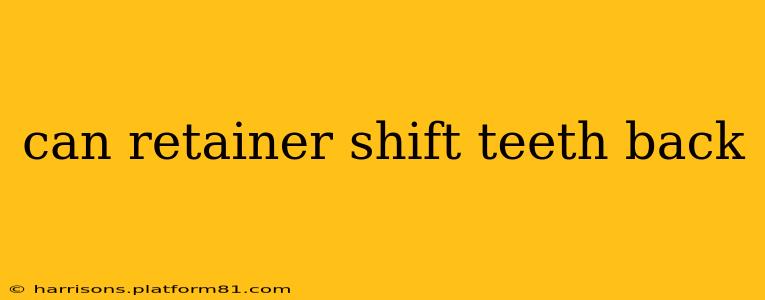Can a Retainer Shift Teeth Back? Yes, But It Depends
The short answer is yes, a retainer can shift teeth back, but it's not a guaranteed outcome and depends on several factors. Retainers are designed to maintain the position of teeth after orthodontic treatment (like braces or Invisalign), but their ability to correct significant shifting depends on the type of retainer, the severity of the shift, and the individual's oral habits.
What Kind of Retainer Do You Have?
The type of retainer plays a crucial role in its ability to correct minor tooth movement.
-
Hawley Retainers: These are the classic removable retainers with a wire arch and acrylic base. While primarily designed for maintenance, they can exert enough pressure to subtly reposition slightly shifted teeth. However, they are less effective for significant movement.
-
Essix (Clear) Retainers: These clear, plastic retainers are more comfortable and less visible, but generally offer less corrective power than Hawley retainers. They are better suited for maintaining existing tooth alignment than for correcting significant shifts.
-
Fixed (Bonded) Retainers: These are permanently cemented to the back of the teeth and are excellent for maintaining alignment. However, they are not designed to shift teeth back; they only prevent movement.
How Significant is the Tooth Shift?
Minor shifts, like slight crowding or a tooth that has moved a millimeter or two, might be correctable with a retainer, especially a Hawley retainer worn consistently. However, significant tooth movement requiring extensive realignment will likely need professional intervention—a visit to your orthodontist is necessary.
What are Your Oral Habits?
Consistent retainer wear is crucial. If you only wear your retainer occasionally or inconsistently, it's less likely to correct any shifting. Furthermore, habits like grinding your teeth, thumb sucking, or using your teeth to open packages can counteract the retainer's efforts.
How Long Has the Shift Been Present?
The longer teeth have been out of place, the more difficult it will be to shift them back with a retainer alone. Bone remodeling takes time, and prolonged misalignment can make correction more challenging.
Can a Retainer Correct Significant Tooth Movement?
No. A retainer is not a substitute for orthodontic treatment. If you have significant tooth movement, a retainer alone will not be sufficient. You need to consult your orthodontist for a professional evaluation and treatment plan. They may recommend additional orthodontic work, such as Invisalign or braces, to correct the issue.
How Often Should I Wear My Retainer?
This depends on your orthodontist's instructions, but generally, full-time wear (24/7) is recommended for the first few months after orthodontic treatment. Your orthodontist will eventually determine the appropriate wear schedule as your teeth stabilize. Even after the initial phase, consistent retainer use is vital to maintain long-term results.
What Should I Do If My Teeth Have Shifted?
If you notice your teeth have shifted, schedule an appointment with your orthodontist immediately. They can assess the situation, determine the cause, and recommend the appropriate course of action, which may or may not involve a new retainer or further orthodontic treatment. Ignoring the issue will only make it more difficult and costly to correct in the future.
By understanding these factors, you can better grasp your retainer's capabilities and make informed decisions about maintaining your smile. Remember, consistent communication with your orthodontist is key to long-term oral health.
